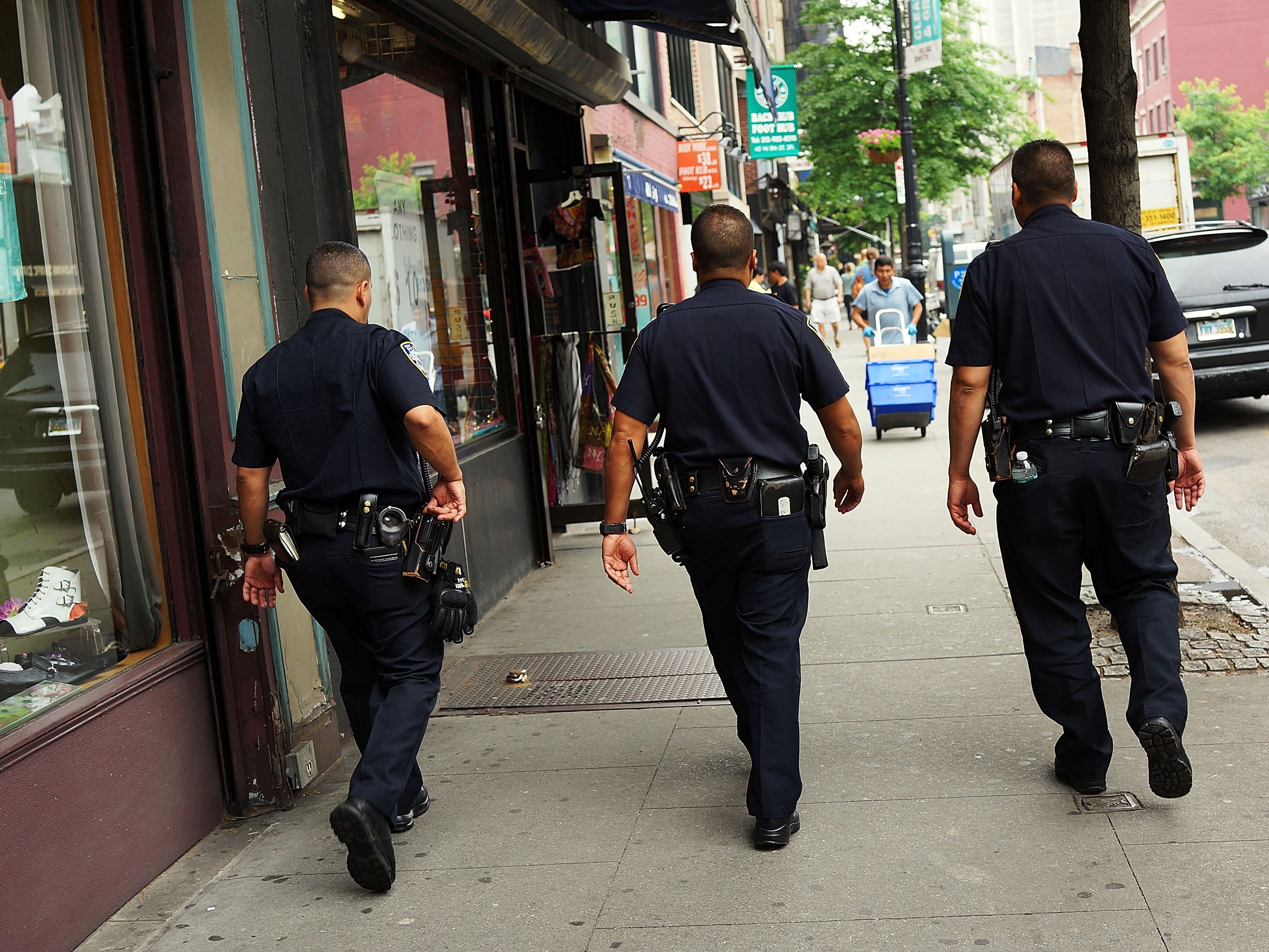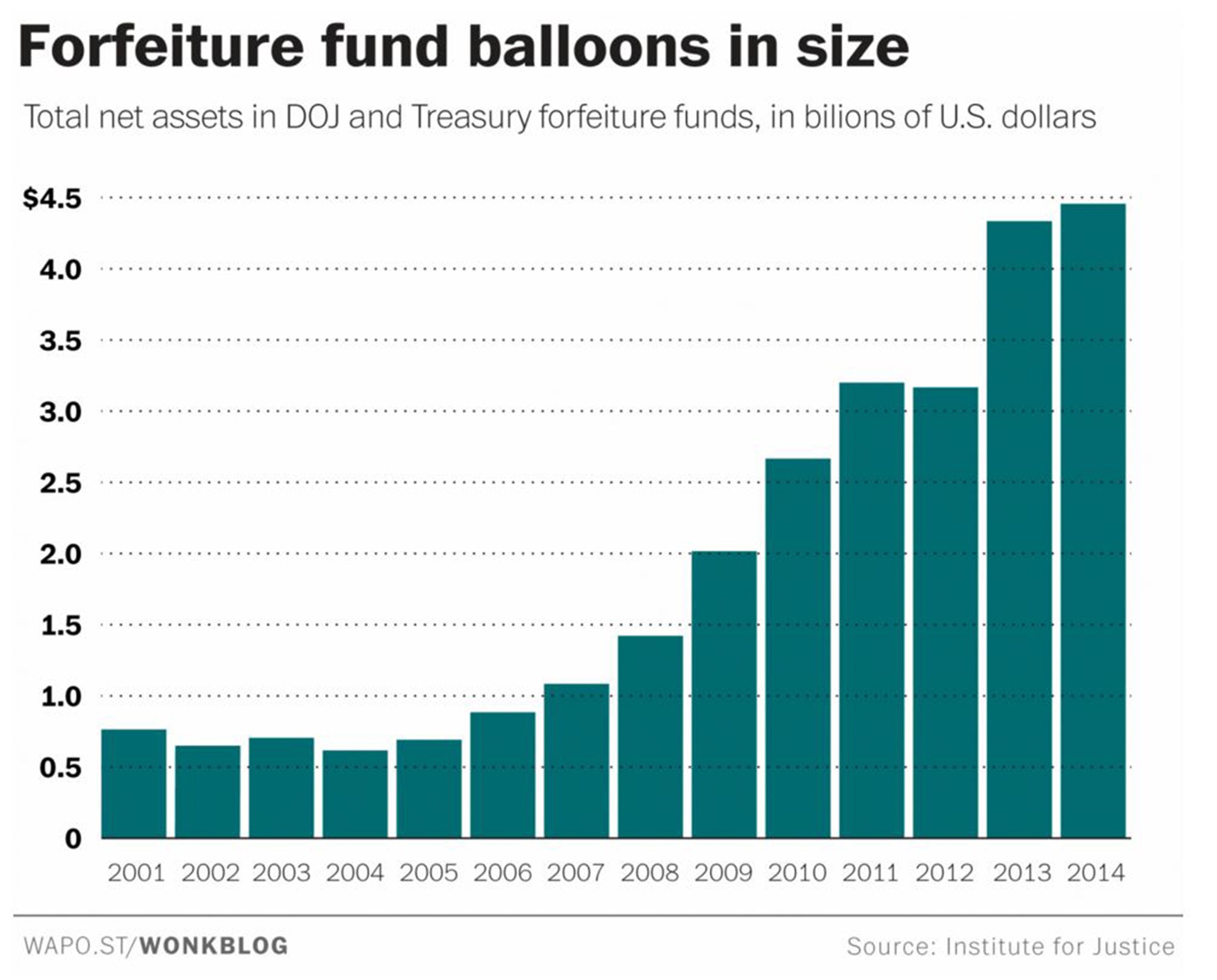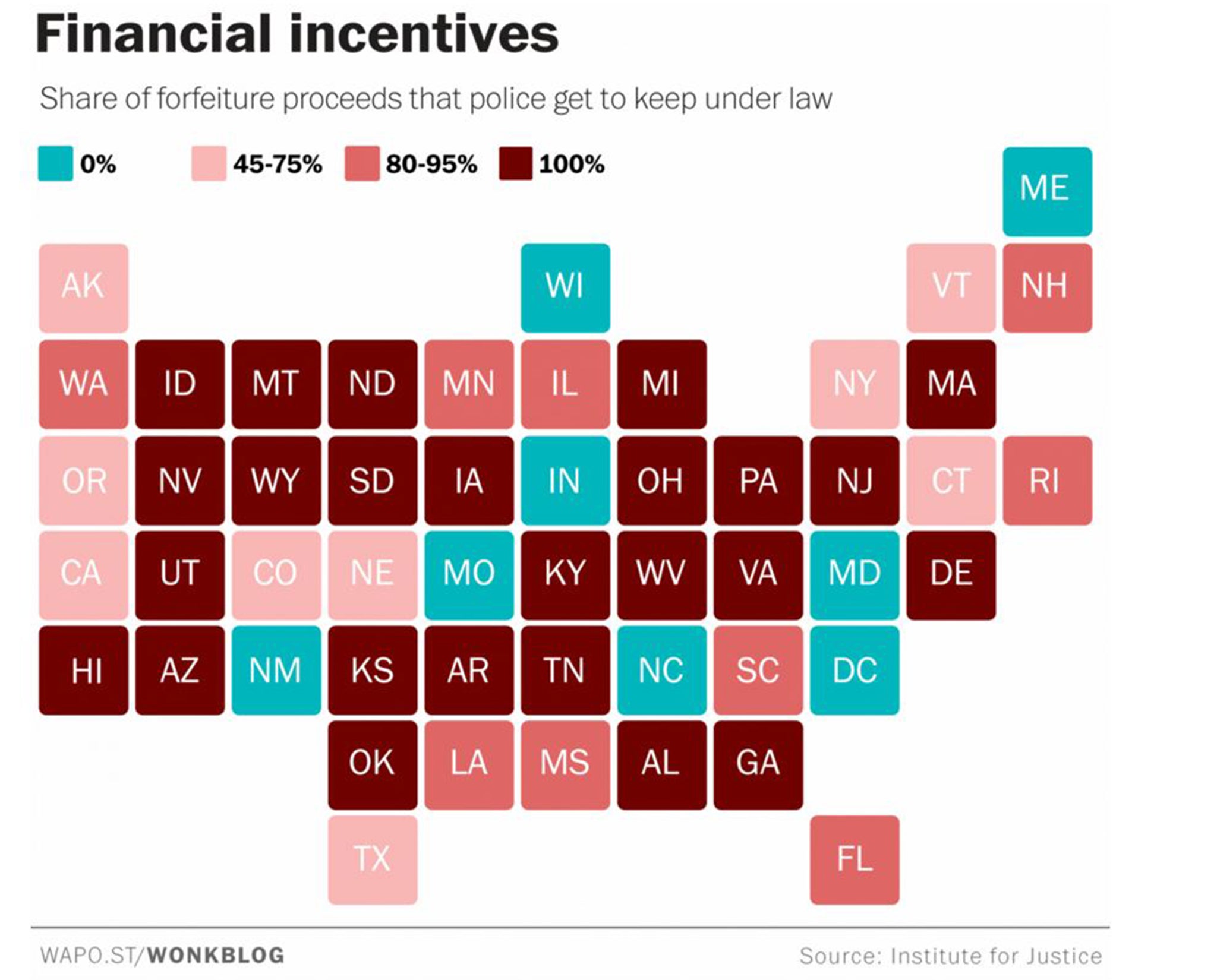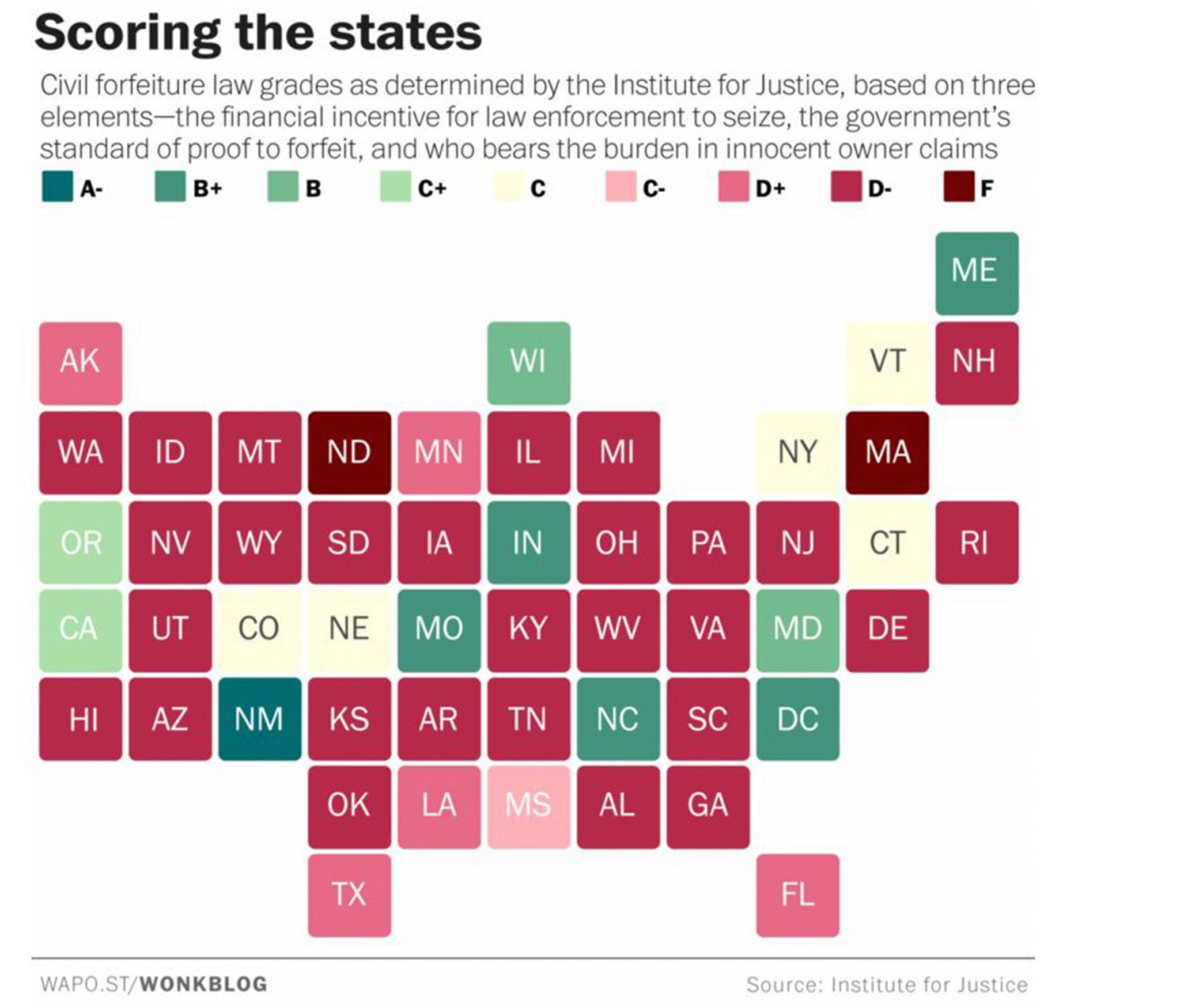US police seize more cash and assets during tough economic times, says new report
Civil asset forfeiture 'is happening to every day people in every state across the country'

Recent years have brought public scrutiny on a controversial law enforcement practice known as civil asset forfeiture, which lets police seize and keep cash and property from people who are never convicted — and in many cases, even charged — with wrongdoing. But despite a growing public outcry spurred in part by news investigations and congressional hearings, a new report on 10 November from the Institute for Justice, a non-profit civil liberties law firm, finds that the past decade has seen a “meteoric, exponential increase” in the use of the practice.
The government does not measure the number of times per year that assets are seized. But one common measure of the practice is the amount of money in the asset forfeiture funds of the Department of Justice and the U.S. Treasury, the two agencies that typically perform forfeitures at the federal level. In 2008,there were less than $1.5 billion in the combined asset forfeiture funds of the Justice Department and the U.S. Treasury, according to the report. But by 2014, that number had tripled, to roughly $4.5 billion.

In an e-mail, a Justice Department spokesman pointed out that big cases, like the $1.7 billion Bernie Madoff judgment and a $1.2 billion case associated with Toyota, have led to large deposits to forfeiture funds in a single year. It's not possible to determine precisely how much of these deposits have been subsequently released to victims.
The figures above show the size of the funds after deposits and expenditures are accounted for. “In a given year, one or two high-dollar cases may produce unusually large amounts of money—with a portion going back to victims—thereby telling a noisy story of year-to-year activity levels,” the report found. The numbers above represent a more stable and accurate account of forfeiture activity, according to the Institute for Justice.
“Even without those major cases, the overall trend is still upward,” said report co-author Lisa Knepper.
One possible explanation for the recent rise is that “the years 2008 to 2014 were some lean economic years,” said report co-author Dick Carpenter in an interview. “Forfeiture is an attractive way to keep revenue streams flowing when budgets are tight.”
Law enforcement officers generally acknowledged this factor, according a Washington Post investigation last year: “All of our home towns are sitting on a tax-liberating gold mine,” Deputy Ron Hain of Kane County, Ill., wrote in a self-published book in 2011.
Critics of the system also say that the increase in forfeiture activity is due largely to the profit motive created by laws which allow police to keep some or all of the assets they seize.
“It’s possible that the spike is due to a growing recognition by law enforcement of the profitability of forfeiture,” said Carpenter. He notes that Congress made some attempt to rein in forfeiture abuses with a modest reform bill in 2000. After that, “elected officials stopped paying attention,” he said. “The combination of low procedural hurdles, high profit incentive, and meager accountability or oversight created a rich environment for forfeiture activities to flourish.”
Civil asset forfeiture “is happening to every day people in every state across the country,” the Institute for Justice's Carpenter said. “There are people here in your community to whom this is happening. This is not something isolated happening to drug kingpins and mafiosos.”
In one case represented by the Institute, a drug task force seized $11,000 from a college student at an airport because his luggage smelled like marijuana. They lacked evidence to charge him with any crime, but they kept the money and planned to divvy it up between 13 different law enforcement agencies, most of which had nothing to do with the actual seizure of cash.
In another case, the IRS emptied a convenience store owner's bank account because they suspected he was depositing cash in such a way as to avoid reporting requirements for large deposits. He eventually won his money back after a lengthy court fight.
“Once property is seized,” the report explains, “owners must navigate a confusing, complex and often expensive legal process to try to win it back.” In Illinois, for example, in order to challenge a seizure property owners must pay a bond of up to 10 percent of the property's value. If they lose their challenge, they must pay for the full legal cost of the proceedings. “Even if they win, they lose 10 percent of the bond on top of whatever attorney costs they accrued,” the report found.
Profit motive
Like many of the more controversial aspects of the present-day criminal justice system, civil asset forfeiture's roots lie in the war on drugs. In the 1980s, law enforcement officers said they needed a tool to help capture cartel leaders and large-scale drug traffickers, who are difficult to pin criminal cases on. So Congress amended the Comprehensive Drug Abuse Prevention and Control Act to create the Department of Justice's Asset Forfeiture Fund.
One feature of the fund was that it allowed agencies to keep the cash and property they seized, creating something of a profit incentive. “For the first time, agencies could obtain a financial benefit from the proceeds of forfeited properties, using funds to do everything from purchase vehicles to pay overtime,” the report explains. States followed suit by updating their own forfeiture laws.

At the state level there's considerable variation in how much cash and property from seizures law enforcement officers get to keep. In some, like New Mexico and Missouri, 100 percent of seized assets go to state general funds rather than to law enforcement coffers. But in 25 states and at the federal level, police get to keep 100 percent of the assets they seize. “Allowing law enforcement agencies to reap financial benefits from forfeitures encourages the pursuit of property over the impartial administration of justice,” the report argues.
Petty crimes
Asset forfeiture's defenders say that the practice is instrumental in dismantling large-scale criminal enterprises. “The Asset Forfeiture Program is a nationwide law enforcement initiative that removes the tools of crime from criminal organizations,” wrote the chief of the DOJ's Asset Forfeiture and Money Laundering Division in 2007. “The stakes are high. The national security and lives of Americans are at risk.”
But evidence suggests that forfeiture proceedings are often initiated against small time criminals or people who aren't criminals at all. An American Civil Liberties Union report earlier this year found that the median amount seized in forfeiture actions in Philadelphia amounted to $192. These forfeiture actions were concentrated in the city's poorest neighborhoods, the report found.
And according to the Institute for Justice's report, in most states the typical forfeiture amount is very small. The median forfeiture case in Illinois is worth $530, according to the report. In Tennessee it's $502. In Minnesota, $451. Those are hardly kingpin-level hauls.
One more data point supports this contention: at the federal level, at least, “the vast majority of forfeiture victims are never convicted or charged with a crime,” according to Carpenter. Using data obtained via FOIA requests, Carpenter found that 87 percent of federal forfeiture proceedings were civil cases, not criminal ones. “It's troubling that 87% of the time the conviction appears to be irrelevant,” said co-author Lisa Knepper.
Defending forfeiture
The Department of Justice, and many law enforcement groups, maintain that civil forfeiture is an important crimefighting tool in cases when a criminal prosecution may not be possible. “The Department proudly recognizes the value and importance of its asset forfeiture program,”according to written testimony presented by the DOJ to Congress earlier this year. “Civil forfeiture enables the government to recover property when criminal prosecution of the possessor of the property may not be appropriate or feasible.”
The testimony points to high-profile cases like that of Kenneth Lay, of Enron infamy, who died before he could be criminally sentenced. “Civil forfeiture was the only way to secure millions of dollars of Lay’s assets, which were then used to compensate victims of the Enron fraud,” the testimony concludes. The federal government also used civil forfeiture to seize dozens of pit bulls from Michael Vick's dog fighting operation, many of whom were subsequently adopted.
“Appropriate use of asset forfeiture law allows the Justice Department to safeguard the integrity, security, and stability of our nation’s financial system and provides unique means to go after criminal and terrorist organizations, while protecting the civil liberties of all Americans,” said Justice Department spokesman Peter Carr in an email. “As we continue our comprehensive review of the asset forfeiture program, we will stay focused on deterring criminal activity, returning the proceeds of crime to victims, and defending the rights of our citizens.”
Strengthening safeguards
But critics like the Institute for Justice say that civil rights protections for innocent property owners are not nearly strong enough. At the state and federal levels, for instance, there's little transparency into what types of assets are seized — or how they're used by law enforcement officers. Few states have any reporting requirements in place. And in most of them, “the quality of the data ranged from useless to pathetic,” Carpenter said. “The ability to do any basic or simple analysis to know what is going on is basically impossible.”

As part of its report, the Institute issued state-level grades based on a variety of criteria, like the share of forfeited funds that cops get to keep and protections for innocent owners. Most states and the federal government earned a D-. Two states, Massachusetts and North Dakota, earned an F for the incredibly low standard of proof required to forfeit goods there. Only one state, New Mexico, earned above a B+, primarily because of high-profile forfeiture reforms recently passed there.
The Institute for Justice would like to see civil forfeiture abolished completely. “The idea that you can take somebody's property without convicting them should be anathema in our criminal just system. And police shouldn't be able to profit from this,” said report co-author Lisa Knepper.
“A law enforcement officer will typically say that this is stuff taken from criminals,” Dick Carpenter said. “My response is, how would they know? They don't charge anyone, much less convict them.” He points out that no studies have been done to determine the effects of asset forfeiture on crime rates.
“People say this is an essential crimefighting tool but there's no evidence,” Carpenter said.
At the federal level, numerous reform efforts are being considered in Congress. The FAIR act, introduced this year with bipartisan support, would increase the burden of proof required in federal cases and direct the Department of Justice to deposit forfeited assets in the Treasury Department's general fund, rather than to law enforcement accounts.
Momentum appears to be on critics' side.
The issue has united organizations on opposite ends of the political spectrum, including the ACLU and the Koch brothers. Even lawmakers who are often skeptical of the need for policing reform, like Senator Chuck Grassley of Iowa, have argued that the practice needs to be changed. “Civil asset forfeiture leads government to exceed its just powers over the governed,” he said in a statement earlier this year.
Copyright: Washington Post
Join our commenting forum
Join thought-provoking conversations, follow other Independent readers and see their replies
Comments